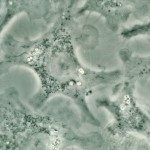Lien vers Pubmed [PMID] – 21209364
Am. J. Physiol., Cell Physiol. 2011 Apr;300(4):C850-9
Mononuclear phagocytes are among the first immune cells activated after pathogens invasion. Although they all derive from the same progenitor in the bone marrow, their characteristics differ on the compartment from which they are derived. In this work, we investigated the contribution of phagocytosis for tumor necrosis factor (TNF) production by murine mononuclear phagocytes (monocytes, peritoneal and alveolar macrophages) in response to heat-killed Staphylococcus aureus (HKSA). Mononuclear phagocytes behaved differently, depending on their compartment of residence. Indeed, when bacterial uptake or phagosome maturation was blocked, activation through membrane receptors was sufficient for a maximal production of TNF and interleukin-10 by peritoneal macrophages. In contrast, monocytes, and to a lesser extent alveolar macrophages, required phagocytosis for optimal cytokine production. While investigating the different actors of signalization, we found that p38 kinase and phosphatidylinositol 3-kinase were playing an important role in HKSA phagocytosis and TNF production. Furthermore, blocking the α(5)β(1)-integrin significantly decreased TNF production in response to HKSA in all three cell types. Finally, using mononuclear phagocytes from NOD2 knockout mice, we observed that TNF production in response to HKSA was dependent on NOD2 for monocytes and peritoneal macrophages. In conclusion, we demonstrate that the mechanisms of activation leading to TNF production in response to HKSA are specific for each mononuclear phagocyte population and involve different recognition processes and signaling pathways. The influence of the compartments on cell properties and behavior should be taken into account, to better understand cell physiology and host-pathogen interaction, and to define efficient strategies to fight infection.

